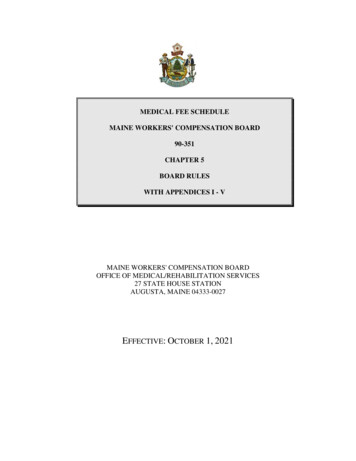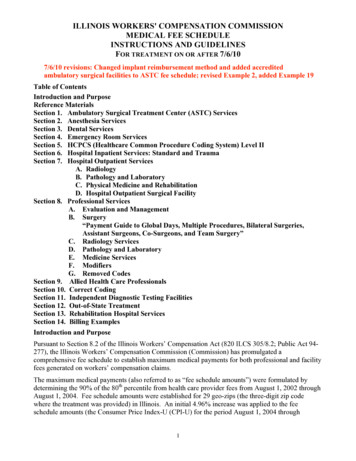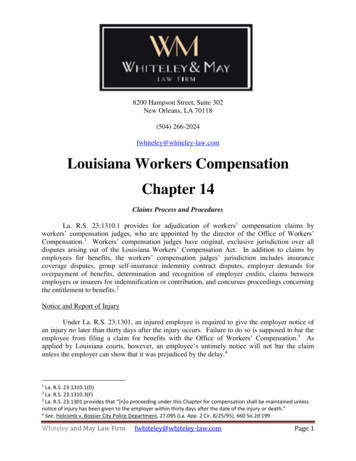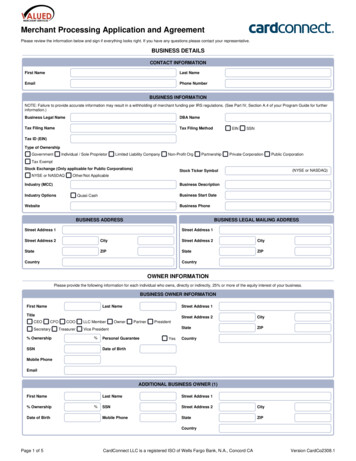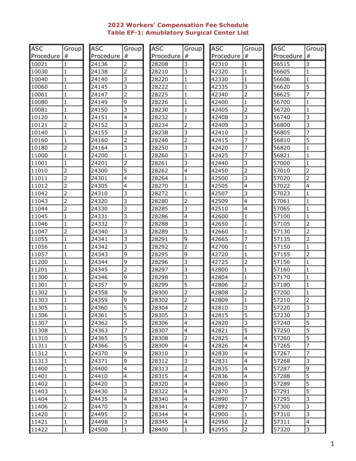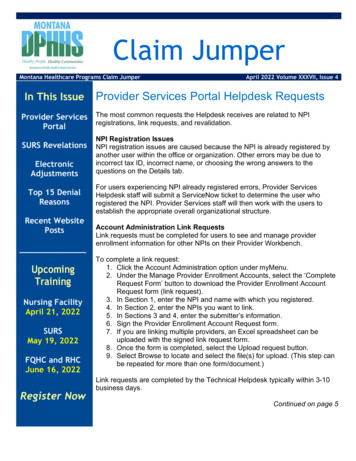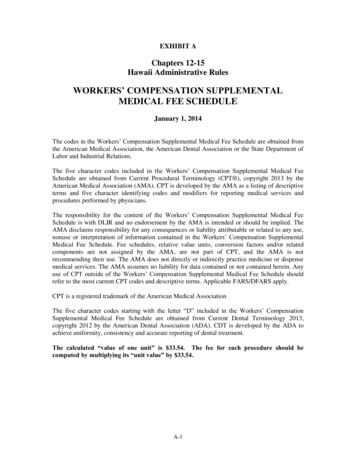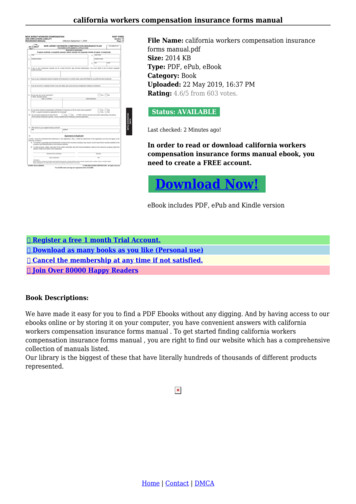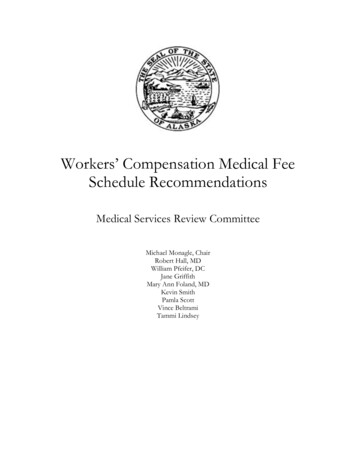
Transcription
Workers’ Compensation Medical FeeSchedule RecommendationsMedical Services Review CommitteeMichael Monagle, ChairRobert Hall, MDWilliam Pfeifer, DCJane GriffithMary Ann Foland, MDKevin SmithPamla ScottVince BeltramiTammi Lindsey
Department of Labor andWorkforce DevelopmentWorkers’ Compensation DivisionPost Office Box 115512Juneau, Alaska 99811-5512Main: 907.465.6059Fax: 907.465.2797June 1, 2015To: Heidi Drygas, Commissioner of the Department of Labor and Workforce DevelopmentThe Medical Services Review Committee (MSRC) is pleased to present the following reportoutlining its workers’ compensation medical fee schedule recommendations. The Committee is anadvisory body established by the Alaska Legislature in 2005 to assist and advise the Department ofLabor and Workforce Development and the Alaska Workers’ Compensation Board (Board) inmatters involving the appropriateness, necessity, and cost of medical and related services providedunder the Alaska Workers’ Compensation Act.On April 23, 2014, the Alaska Legislature passed HB316, chapter 63 SLA 2014, which becameeffective September 20, 2014. This legislation required the MSRC to develop new workers’compensation medical fee schedules, and submit their recommendations to you for review prior totransmission to the Board for adoption by regulation.In this report the committee presents its analysis, its findings, and its recommendations for yourreview. It is the committee’s belief that these recommendations will maintain employee access tomedical care while improving medical cost stability and predictability to the employers who arerequired by law to pay for those benefits.Sincerely,Michael P. MonagleChair, Medical Services Review CommitteeDirector, Division of Workers’ Compensation
Table of ContentsACKNOWLEDGEMENTS . 1EXECUTIVE SUMMARY. 2PURPOSE OF THIS REPORT . 2BACKGROUND . 2SUMMARY OF MSRC ACTIVITY . 3MILESTONES. 4METHODOLOGY USED BY THE MSRC . 4Physician Fee Schedule . 5Inpatient Fee Schedule . 5Outpatient Fee Schedule . 6FINDINGS OF THE MSRC . 7Medical Costs . 7General . 7Physician Fee Schedule . 8Hospital Inpatient Fee Schedule . 8Hospital Outpatient Fee Schedule . 9Ambulatory Surgical Centers. 9Anesthesia . 9Prescription Drugs . 9Air Ambulance Fee Schedule . 9Billing and Payment Rules .10Other Findings .10RECOMMENDATIONS OF THE MSRC .11Physician Fee Schedule .11Hospital Inpatient Fee Schedule .11Hospital Outpatient Fee Schedule .11Ambulatory Surgical Centers.12Anesthesia .12Prescription Drugs .12Air Ambulance Fee Schedule .12Billing and Payment Rules .12Other Recommendations .14GLOSSARY .15APPENDIX OF PROPOSED SAMPLE FEE SCHEDULES.16
ACKNOWLEDGEMENTSAs Chair of the Medical Services Review Committee (MSRC), I’d like to acknowledge thetremendous amount of time the committee members have dedicated to this task. Beginning in July2014, the committee held eleven public meetings analyzing data, reviewing reports, listening totestimony, and learning the complex rules of medical billing and payment formulas. As full-timeprofessionals, the time these committee members took away from their practices and professions isdeeply appreciated.I would also like to acknowledge the following professionals whose input and subject matterexpertise was invaluable to the committee’s work: Eric Anderson, OptumKevin Barry, Alaska Surgery CenterKira Boyd, Automated Healthcare SolutionsStephanie Brewer, OptumRaji Chadarevian, National Council on Compensation InsuranceLisa Anne Forsythe, Coventry HealthJuliann McCabe, Guardian FlightCarla Gee, OptumDr. Anthony Hamm, DC, FACO, President of the American Chiropractic Association andco-chair of the American Medical Association Specialty Society RVS HCPACSheila Hansen, CorvelScott Kirby, LifeMed AlaskaDon Lipsy, Coventry HealthMatt Mayfield, FAIR HealthChris Rappleye, Guardian FlightSusan Schulte, National Council on Compensation InsuranceMisty Steed, PacBluCathy Wilson, Automated Healthcare SolutionsAny errors or omissions contained in this report are my responsibility.Michael P. Monagle, ChairMedical Services Review CommitteeFee Schedule Summary ReportPage 1
EXECUTIVE SUMMARYPURPOSE OF THIS REPORTThe purpose of this report is to convey the findings and recommendations of the MSRC to theCommissioner of Labor and Workforce Development and the Alaska Workers’ CompensationBoard, as required by Alaska Statute 23.30.097, as amended in 2014 by HB316.BACKGROUNDBeginning in 2000, Alaska’s workers’ compensation premium rates started rising rapidly. Between2000 and 2006, premium rates rose 61.8%. In 2000, Alaska’s workers’ compensation premium ratesranked 28th in the nation. By 2006, Alaska had risen to the top of the premium rate rankings,having the dubious distinction of having the highest premium rates in the nation.Analysis showed that the primary cost driver was medical costs, which had risen from 52% of claimcosts in 1988 to 76% of claim costs by 2006. From 2000 to 2006, total medical benefit costs rose50.9%, from 81.1 million to 122.4 million.As part of the legislative reforms in 2005, SB130 (chapter 10 FSSLA 2005), AS 23.30.095(j), theAlaska Legislature established the Medical Services Review Committee (MSRC) to “to assist andadvise the department and the board in matters involving the appropriateness, necessity, and cost ofmedical and related services provided under this chapter.”The MSRC is composed of one member who is a member of the Alaska State Medical Association; one member who is a member of the Alaska Chiropractic Society; one member who is a member of the Alaska State Hospital and Nursing Home Association; one member who is a health care provider, as defined in AS 09.55.560; four public members who are not within the definition of "health care provider" in AS09.55.560; and one member who is the designee of the commissioner and who shall serve as chair.The members are appointed by the Commissioner of Labor and Workforce Development. No termsfor the members are set out in statute or regulation - they serve at will of the Commissioner.Medical Services Review CommitteeFee Schedule Summary ReportPage 2
Director, Division of Workers'CompensationAk State Medical Assn Hall, MDRobert J. Orthopedic PhysiciansAnchorage, Inc.Ak Chiropractic Society Pfeifer, DC William Family Chiropractic ClinicAk State Hospital &GriffithJaneProvidence Alaska MedicalNursing Home AssnCenterMedical Care Provider Foland, MD Mary Ann Primary Care AssociatesPublic MemberSmithKevinAk Municipal League JointInsurance AssociationPublic MemberScottPamAk Timber Insurance ExchangePublic MemberPublic MemberBeltramiLindseyVinceTammiAFL‐CIOAk National Insurance CoIn 2014, the Alaska Legislature passed HB316, Chapter 63, SLA 2014. The bill became effectiveSeptember 20, 2014. HB316 tasked the Workers’ Compensation Medical Services ReviewCommittee with proposing new fee schedules founded on resource based relative value scale(RBRVS) methodology to the Workers’ Compensation Board, through the Commissioner, foradoption by regulation.SUMMARY OF MSRC ACTIVITYThe MSRC held 11 meetings between July 2014 and April 2015: July 7, 2014; September 5, 2014;September 19, 2014; October 24, 2014; November 7, 2014; December 12, 2014; January 15-16,2015; January 29, 2015; February 23, 2015; March 16, 2015; and April 20, 2015. All of thesemeetings were open to the public, and public comment was taken at each meeting. The agenda andminutes of those meetings are posted online at http://labor.alaska.gov/wc/med-serv-comm.htm.At its July 2014 meeting, the committee adopted the following action plan:1. Collect data.2. Select a third party vendor to assist the Division and the MSRC in developing fee schedules.3. Analyze data and establish conversion factors, transitioning maximum allowablereimbursement rates (MAR) from the 2010 usual customary and reasonable (UCR) workers’compensation fee schedule to MAR rates based on the Centers for Medicare and MedicaidServices (CMS) resource based relative value system (RBRVS).4. Obtain feedback on the proposed conversion factors from the MSRC member constituencygroups, i.e. the State Medical Association (member Hall), the Alaska Chiropractic Society(member Pfeifer), the Hospital and Nursing Home Association (member Griffith), at largehealth care providers (member Foland), and the general public (members Smith, Scott,Lindsey, and Beltrami).5. Submit adopted conversion factors to the Commission for review, and referral to theWorkers’ Compensation Board for adoption in regulation.Medical Services Review CommitteeFee Schedule Summary ReportPage 3
MILESTONES In August 2014, Optum was chosen as the vendor for fee schedule development. Optumhas over 20 years’ experience assisting state development of workers’ compensation feeschedules, including Alaska, Connecticut, Delaware, Florida, Georgia, Idaho, Illinois, Maine,Minnesota, Mississippi, Montana, Nebraska, New York, North Carolina, South Carolina,Texas, Utah, and Vermont. A contract with Optum was finalized in late September, 2014.FAIR Health was selected to provide medical billing data. FAIR Health is a national,independent nonprofit corporation who collects medical billing data and provides dataproducts to clients. A contract with FAIR Health was finalized in October 2014.The National Council on Compensation Insurance (NCCI) was selected to provide medicaldata from workers’ compensation insurers. NCCI is contracted by the Alaska Division ofInsurance (DOI) as the rate setting organization for the State of Alaska. NCCI collects datafrom all workers’ compensation insurers doing business in Alaska, excluding self-insuredemployers, analyzes that data, and makes premium rate recommendations to DOI for thecoming calendar year. Recognizing the rising influence of medical costs on workers’compensation rates, NCCI began collecting medical data in 2010. NCCI is the ratingorganization for 38 states.On September 19, 2014, the committee was briefed by Dr. Anthony Hamm, DC, FACO,President of the American Chiropractic Association and co-chair of the AMA SpecialtySociety RVS Health Care Professionals Advisory Committee. Dr. Hamm presented anoverview of how relative values are determined and the work of RVS Update Committees incollaboration with the AMA.Nondisclosure agreements were finalized between FAIR Health, Optum, and NCCI inOctober 2014.Data from NCCI was received in October 2014 and provided to Optum for analysis.Data from FAIR Health was received in November 2014, and provided to Optum foranalysis.The first physician data analysis was received from Optum in December 2014.The committee received presentations on air ambulance services from Guardian Flight andLifeMed Alaska at the December 12, 2014 meeting.The first facility (inpatient and outpatient) data analysis was received from Optum in January2015.The first draft recommendations were produced by the committee at its January 29, 2015meeting.Final recommendations were approved by the committee at its April 20, 2015 meeting.METHODOLOGY USED BY THE MSRCOptum consulted with the Medical Services Committee to create a proposed fee schedule whichwould transition Alaska’s current workers’ compensation fee schedule that is reflective of the 90thpercentile of usual, customary, and reasonable (UCR) charges, to a resource based relative valuesystem (RBRVS).Optum’s analysis was based on data from NCCI’s 2013 medical data call, FAIR Health’s Spring2014 billing data, CMS 2015 relative values and fee schedules, CMS Medicare Provider Analysis andReview (MEDPAR) data, CMS Outpatient Standard Analytical File (OPSAF), and the existing 2010workers’ compensation medical fee schedule.Medical Services Review CommitteeFee Schedule Summary ReportPage 4
Optum’s analysis was based on billed charges for professional fees and paid charges for facility fees.Conversion factors were selected which would produce values between the 75th and 80th percentileof FAIR Health data.Physician Fee ScheduleOptum obtained summary information from NCCI of carrier submitted claims data with calendaryear 2013 dates of service. For each Common Procedure Terminology (CPT) code, Anesthesiology(ANES) code, and Healthcare Common Procedure Coding System (HCPCS) code evaluated, datafields included procedure code, modifier, second modifier, place of service, billed charge amount,paid amount, number of transactions and number of units for professional services. Totaltransactions and frequencies in the NCCI data were 219,237 and 1,642,896 respectively.The data was then run through a validation process. Such validation included checking for old orinvalid procedure codes and inappropriate procedure code/modifier combinations. Records withmodifiers representing assistant surgeon were eliminated as not to inflate the occurrences ofprocedures (as the surgeon’s record should have also been submitted). HCPCS transactionsclassified under ‘other’ place of service (not provider, not facility) were also excluded. Finalnumbers used in the analysis were 213,282 transactions and 1,603,008 units.Occurrences per code, applicable modifiers and place of service were then determined and analyzedwith the current fee schedule to create total dollar amounts by service area (surgery, radiology,laboratory/pathology, medicine, evaluation and management, and HCPCS). Correspondinggeographic adjusted ‘non-facility’ and ‘facility’ relative values from RBRVS were used to determinetotal relative value units. The total dollar amounts were divided by total relative value units tocalculate fee schedule neutral conversion factors to use as a baseline.Codes that were not valued in RBRVS used, when available, associated Alaska information from theClinical Diagnostic Laboratory (CLAB), Durable Medical Equipment, Prosthetics and Orthotics, andSupplies (DMEPOS), Average Sale Price (ASP), and Parenteral and Enteral Nutrition Items andServices (PEN) fee schedules.FAIR Health’s total dollars (based on occurrences) were also calculated to see how the current feeschedule and the proposed fee schedule compared to commercial data. The 75th percentile to 80thpercentile range was used as a guideline for determining conversion factors (RBRVS) and multipliers(other CMS files) for the data.Inpatient Fee ScheduleOptum used the appropriate relative weights for each federal fiscal year in its analysis (i.e., FFY 2012for 2012 data, FFY 2013 for 2013 data), and summed the relative weights and total payments foreach year’s inpatient claims. For 2013 data this was 357.72 and 8,719,881.99. Dividing the totalpayments by the total relative weights produces an effective Medicare base rate of 21,449.74. As across-check, this produced a workers’ compensation case mix index of 1.873 which is in line withOptum’s national calculations and what the company has observed in other states.The 2015 total “all in” base rates ranged from 7,498.69 for Central Peninsula General Hospital to 12,991.50 for Yukon Kuskokwim Delta Regional Hospital. The average base rate was 8,944.40.Because Optum did not have volumes by hospital, the rate could not be adjusted to reflect differentMedical Services Review CommitteeFee Schedule Summary ReportPage 5
utilization patterns. Optum used the 2015 average rate for the 2012 analysis in order to keeprelativity between the 2012/2013 data.Optum did not include the disproportionate (DSH) per claim amount in the calculated conversionfactor. Some Alaska hospitals qualify for DSH per claim payments; some do not. The average DSHper claim amount in Alaska is 973.25. (Including the DSH per claim payment would increase thetotal payments by 185,891 for 2013 data.)Based on this, Optum estimated current payments as 239.8% compared with Medicare. For 2012,the percentage to Medicare was 255.7%.Outpatient Fee ScheduleHospital Outpatient followed a similar process except that Optum used the 2015 Medicare weightsfor both the 2012 and 2013 data. This is because Medicare has been moving various CPT/HCPCScodes into differing Ambulatory Payment Classifications (APCs) and changing their weight,sometimes substantially. Optum wanted to keep relativity between the data years for accuratecomparison.Optum summed the relative weights and total payments for each year’s outpatient claims. For 2013data this was 31,750.6 and 7,042,049.83. Dividing the total payments by the total relative weightsproduced an effective Medicare base rate of 221.79.Under the APC system, Medicare bundles some items together and only establishes a payment forthe primary service. Optum used all payments reported so bundled items were included in thecalculation where they existed, which presumes a 1:1 correlation between bundled items and primaryitems that may not exist. The result may somewhat over- or under-state the payments because ofthis. Typically, bundled payment items represent relatively small amounts. Based on an analysis ofnational Medicare data, Optum estimate the margin of error is likely to be within 1-3% either way.Hospital outpatient only has a single adjustment between hospitals, by wage index. The formula isHospital rate (national rate) * 60% * (hospital wage index)(national rate) * 40%There are two 2015 wage indexes in Alaska (1.3042 and 1.9343) with a substantial differencebetween them. As with inpatient, because we did not have volumes by hospital, we used an averagewage index of 1.3310 to determine the comparison base rate of 101.72.Although the volumes differed between 2012 and 2013, the comparison to Medicare producedalmost the same results for each year. The 2013 calculation estimated the percentage to Medicare as218.0%.Medical Services Review CommitteeFee Schedule Summary ReportPage 6
FINDINGS OF THE MSRCThe MSRC’s findings follow in this section. Recommendations are listed separately under the“Recommendations of the MSRC” section.Medical CostsThe committee finds that workers’ compensation medical costs continue to be the significant costdriver for workers’ compensation premiums.Information presented by NCCI at the October 22, 2014 Alaska State Advisory Forum showed thatAlaska’s workers’ compensation medical costs are significantly higher than countrywide. In Alaska,medical benefits comprise 74% of total benefit costs, compared to 59% countrywide. Alaska’saverage medical claim severity on a time loss claim averaged 53,000 per claim, compared to 29,000countrywide. Alaska’s average medical claim severity on a permanent partial impairment caseaveraged 95,100, compared to 40,900 countrywide.NCCI’s September 2014 Medical Data Report shows that Alaska’s average medical payments aresignificantly higher than regional and countrywide average medical payments. Surgical – 377% higher than regional and 302% higher than countrywide Radiology – 313 % higher than regional and 267% higher than countrywide Physical/General Medicine – 179% higher than regional and 213% higher than countrywide Evaluation & Management – 186% higher than regional and 202% higher than countrywide Hospital Inpatient – 178% higher than regional and 166% higher than countrywide Hospital Outpatient – 160 % higher than regional and 131% higher than countrywide Ambulatory Surgical Centers – 250% higher than regional and 168% higher thancountrywideNCCI’s January 2014 analysis of the impact of the 2010 workers’ compensation medical feeschedule showed average medical payments increased 8.7% for physicians, 46.22% for hospitalinpatient, 8.5% for hospital outpatient, and 19.0% for ambulatory surgical centers.GeneralWhile HB316 only specifically tasked the committee with proposing conversion factors forphysicians and facilities, the committee finds that it has subject matter expertise and statutoryauthority to make further fee schedule, billing, and payment recommendations that would be helpfuland provide guidance to the Workers’ Compensation Board in adopting regulations.CMS does not produce relative values for all medical services, including pathology and clinical labs,durable medical equipment, parenteral and enteral nutrition items and services, some drug andpharmaceutical supplies. In addition, the committee acknowledged there will be some gaps forprocedure codes not valued by CMS. The committee finds it needed to recommend payment rulesfor unvalued services and gaps where no CMS produces no relative values.Medical Services Review CommitteeFee Schedule Summary ReportPage 7
Physician Fee ScheduleOptum’s analysis of the transition from UCR to RBRVS produced the following physician (nonfacility) conversion values Surgery - 219.6829 Radiology - 313.809 Physical and General Medicine - 79.734 Evaluation and Management - 77.0383 Laboratory and Pathology - 230.1556 Composite (combined non-facility service categories) - 126.714The committee finds that implementing a single conversion factor ( 126.714) would result in asignificant increase or decrease in the MAR, depending on the medical specialty impacted.Therefore, the committee finds it in the best interest of all stakeholders that multiple conversionfactors be established initially, with the goal of migrating toward a single physician scheduleconversion factor over a four year period. The committee notes that a similar phased approach hasalso been recently used in Connecticut, Idaho, Montana, and California.The current workers’ compensation fee schedule does not distinguish between physician servicesprovided in facility and non-facility settings. However since CMS does produce separate relativevalues for physician services provided in facility and non-facility settings, the committee finds thatfee schedules should use relative values where they exist.Optum analyzed CLAB, DMEPOS, ASP, PEN, and air ambulance billed charges, and comparedthese values to corresponding CMS fee schedules, proposing multipliers that would fall within the75th to 80th percentile of the FAIR Health data. That analysis produced the following multipliervalues CLAB – 6.33 DMEPOS – 1.84 ASP – 3.375 PEN – 3.55Optum reports that NCCI’s data reflects a high frequency of work hardening codes, CPT 97545 and97546. Since these codes are not valued by CMS, the committee finds that relative values should beestablished for these codes.Hospital Inpatient Fee ScheduleThere are 9 acute care hospitals subject to the inpatient hospital fee schedule: Alaska RegionalHospital, Bartlett Regional Hospital, Central Peninsula General Hospital, Fairbanks MemorialHospital, Providence Alaska Medical Center, Mat-Su Regional Medical Center, Yukon KuskokwimDelta Regional Hospital, Alaska Native Medical Center, and Mt. Edgecumbe Hospital. Each of thesehospitals has their own operating and capital base rates, as determined by CMS.Optum’s analysis of NCCI and CMS data resulted in an inpatient base rate of 21,449.74, which is239.8% of the average CMS FY15 base rate of 8,944.40 for the 9 Alaskan acute care hospitals. CMSbase rates in Alaska vary from 7,498.69 for the Central Peninsula General Hospital to 12,991.50Medical Services Review CommitteeFee Schedule Summary ReportPage 8
for the Yukon Kuskokwim Delta Regional Hospital. The differences reflect the variances in eachhospital’s operating base rate, capital base rate, and wage index.Because there are so few acute care hospitals in Alaska, rather than using a single conversion factor,the committee finds that it would be more equitable to use separate conversion factors for eachhospital. The committee further finds that these conversion factors should be adjusted to accountfor CMS allowances for disproportionate share, and adjusted for outlier cases.Hospital Outpatient Fee ScheduleOptum’s analysis of the transition from UCR to RBRVS produced an outpatient conversion value of 221.79. Using an urban wage index of 1.3064 (95% of billed charges), the calculated base rate is 87.77, which is 252.7% of the 2015 CMS base rate.CMS has developed status codes finding that certain procedures should not take place in anoutpatient setting. The committee notes that CMS’ patient mix trends to elderly patients or retireeswhereas workers’ compensation trends to younger workers. The committee finds that state specificrules should be recommended to address these status codes, notably status codes C, E, and P.Ambulatory Surgical CentersCMS’ allowance for ASC’s is 68% of the outpatient fee schedule. The 2010 workers’ compensationmedical fee schedule does not distinguish between outpatient services provided at hospitaloutpatient clinics or ambulatory surgical centers. Considering that ASC’s are already taking areduction in professional services, taking a further reduction on facility pricing would beproblematic. The committee finds that ASC’s should be paid at the same rate as other outpatientfacilities.AnesthesiaOptum’s analysis of anesthesia billings reflects that the average unit charge is 145.5271 and theaverage unit payment is 121.4667. The 2010 workers’ compensation fee schedule conversion factoris 121.82.Prescription DrugsThere are multiple benchmarks utilized to determine prescription drug costs, such as averagewholesale price (AWP), wholesale acquisition cost (WAC), actual acquisition cost (AAC), etc.However, AWP continues to be the most widely accepted price benchmark for both billers andpayers. The committee finds that manufacturer’s average wholesale price is the most widelyaccepted prescription drug price benchmark.Air Ambulance Fee ScheduleThe committee finds that establishing an air ambulance fee schedule is necessary to help contain airambulance medivac costs.The NCCI’s November 2014 analysis of air ambulance payments shows that the fixed wing mileagerate in Alaska is 370% higher than regional payments and 211% higher than countrywide payments.Rotary wind air mileage rates are 103% higher than regional payments and 148% higher thancountrywide payments.Guardian Flight and LifeMed Alas
Optum consulted with the Medical Services Committee to create a proposed fee schedule which would transition Alaska's current workers' compensation fee schedule that is reflective of the 90th percentile of usual, customary, and reasonable (UCR) charges, to a resource based relative value system (RBRVS).
